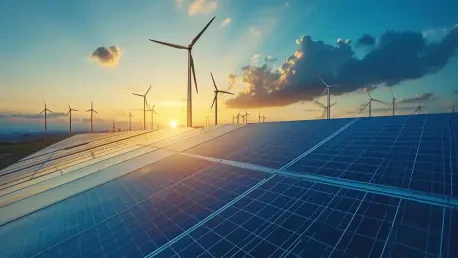The landscape of power generation in the United States is undergoing a historic transformation. For the third consecutive month, clean energy sources are anticipated to surpass fossil fuels in terms of electricity production. This change represents a pivotal moment in America’s energy transition, showcasing the increasing effectiveness and reliance on renewable energy. The data indicates a sustained dominance of clean energy through March and April and projects a continuation into May, marking this period as a significant stretch in the nation’s ongoing journey toward sustainable power solutions. This article explores the factors contributing to this development and the implications it holds for the future of energy generation.
Factors Driving Clean Energy Prevalence
Record Outputs from Renewable Sources
The notable shift stems from an array of contributing factors, primarily the record outputs from renewable energy sources. The past few months witnessed a considerable surge in solar and hydroelectric production. Solar power alone soared by 33% compared to the previous year’s figures, while hydroelectric dams experienced a 24% increase within the same timeframe. This surge pushed the total clean electricity production up by an impressive 8% compared to the previous year. The increased output from these renewable sources played a key role in establishing clean energy’s majority share in U.S. electricity supplies for the first time in March, a dominance that extended into April.
Natural gas-fired generation has seen a remarkable decline in its share of electricity production. This decrease reached its lowest level in three years during April, facilitating the sustained dominance of clean energy throughout May. The drop in natural gas usage is being driven by higher prices, compelling utility providers to seek more cost-effective power sources. As renewable technologies continue to advance, enhanced efficiency has enabled a more substantial energy output, effectively challenging the hold that fossil fuels formerly had over the nation’s power grid.
The Impact of High Natural Gas Prices
The escalation of natural gas prices has become a dominant factor in the inclination towards cleaner energy alternatives. Throughout the year, the benchmark U.S. Henry Hub natural gas futures recorded an average of $3.70 per million British thermal units, reflecting a substantial 77% rise from the previous year’s average. This dramatic price increase has pushed power suppliers away from relying on gas-fired generation, incentivizing them to prioritize renewable resources instead. In doing so, utility providers are not only reducing costs but also significantly boosting clean energy’s contribution to the overall power generation mix.
Those with more developed renewable portfolios were able to capitalize on these resources extensively, minimizing their reliance on costly gas-fired production. Conversely, providers with limited access to renewables had to increase their coal-fired generation to compensate for the reduced use of natural gas. This shift underscores the financial dynamics driving the broader adoption of clean energy, emphasizing the economic incentives alongside technological advancements that are moving the energy sector toward a more sustainable model.
Challenges and Opportunities Ahead
Anticipated Shifts in Power Demand
As the summer season approaches, the demand for electricity is expected to rise, primarily driven by the increased need for air conditioning in the hot months. This spike in demand might challenge the clean energy majority, as utilities may revert to fossil fuels to meet the heightened energy requirements. However, the growing capacity of solar power generation paired with expanded battery storage across the U.S. grid is expected to mitigate these challenges to some extent. The industry driver lies in maintaining the delicate balance between immediate electricity demands and long-term sustainability objectives.
Despite the traditional summer spike in fossil fuel usage, clean energy is poised to remain closely aligned with its current market share due to technological advancements and strategic resource management. As the demand for cooling power diminishes toward fall, clean energy sources are anticipated to reclaim their position as the primary power providers. This transition will further cement their lead and contribute to a gradual, sustained increase in their prevalence within the energy sector.
Strategic Initiatives to Maintain Clean Energy Dominance
The ongoing evolution of the U.S. power system toward clean energy dominance symbolizes a broader strategic initiative within the industry. By expanding renewable capacity and curtailing dependence on fossil fuels, a pathway is paved toward achieving a more sustainable and economically viable energy future. Utility providers are increasingly investing in infrastructure enhancements that maximize renewable energy outputs. Enhancements in grid technology, along with policy incentives that favor clean power adoption, are fueling this transition.
The focus is now on ensuring reliable energy provision while balancing cost-effectiveness and environmental stewardship. Continued investment in emerging technologies, such as wind and solar innovations, as well as energy storage solutions, will be crucial in maintaining and amplifying clean energy’s share of power generation. As clean energy steps into the forefront, stakeholders must navigate the complexities of integrating these sustainable solutions with traditional systems, ensuring that the transition is both smooth and beneficial for consumers and providers alike.
Future Directions for Energy Transition
The power generation landscape in the United States is experiencing a transformative shift. For the third month in a row, clean energy sources are expected to surpass fossil fuels in electricity production. This shift marks a critical juncture in America’s energy transition, highlighting the growing efficiency and reliance on renewable energy sources. Data suggest a persistent dominance of clean energy not just in March and April, but predicted to extend into May, defining this time as a notable phase in the country’s ongoing drive toward sustainable energy solutions. This milestone underpins the shift toward increasing utilization of renewables such as wind, solar, and hydropower, which are not only reducing the carbon footprint but also proving cost-effective and dependable. The implications of this shift are profound, potentially leading to greater energy independence, economic growth in green sectors, and a cleaner environment. This article delves into the factors fueling this development and examines what it means for future energy generation.









